I first got to try TruTrainer rollers 6 1/2 years ago, and found them to incredibly well built and buttery smooth. They recently sent me a new resistance unit, as well as redesigned rails. I rebuilt the rollers with its original drums, new rails and belts, and the new resistance bar, so let’s revisit this puppy.
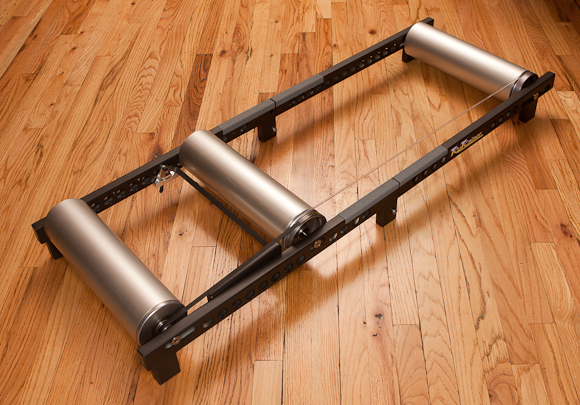
My original writeup goes into more detail, but the Clif Notes version says the TruTrainers are very well built rollers with a hidden flywheel inside the last roller. A drive belt on the middle roller spins the heavy flywheel at higher rpm’s than the roller it’s housed in. With all the high gear ratios in this drivetrain (53/12 = 4.4, 67cm wheel on 11cm drum = 6.1, 11cm drive pulley/2.4cm drive pulley = 4.6) a 100 rpm cadence in 53×12 ends up as about 12,000 rpm’s on the flywheel. This equals lots of inertia, long coasting times, and smoother pedaling action.
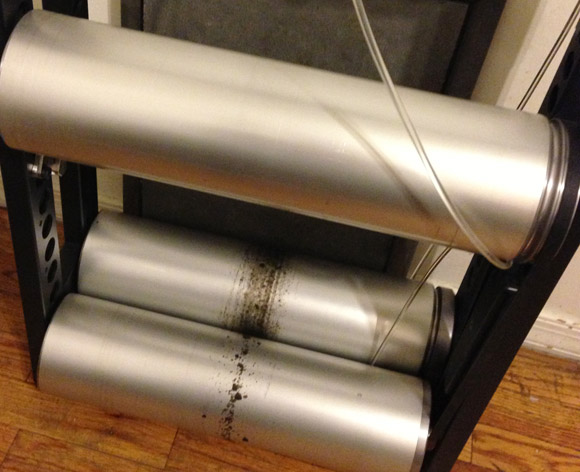
I rode the rollers with brand new IRC tires just before the rebuild and gunked up the first and third rollers real good. How the middle one escaped unscathed is a mystery to me. Ross Belloni of TruTrainer recommended Fast Orange hand cleaner with pumice which brought them back to a like-new state. The cleaner was abrasive enough to remove the rubber but not damage the hard anodization on the rollers. It’s really remarkable how well the drums have held up through six winters of use.
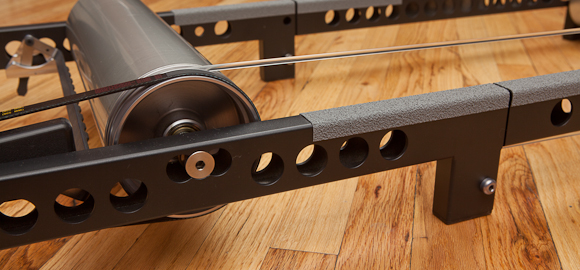
The new rails are drilled out lighter and also about a 1/4" lower to the ground.

Hinged rails are an option. Note how solid and well built they are.
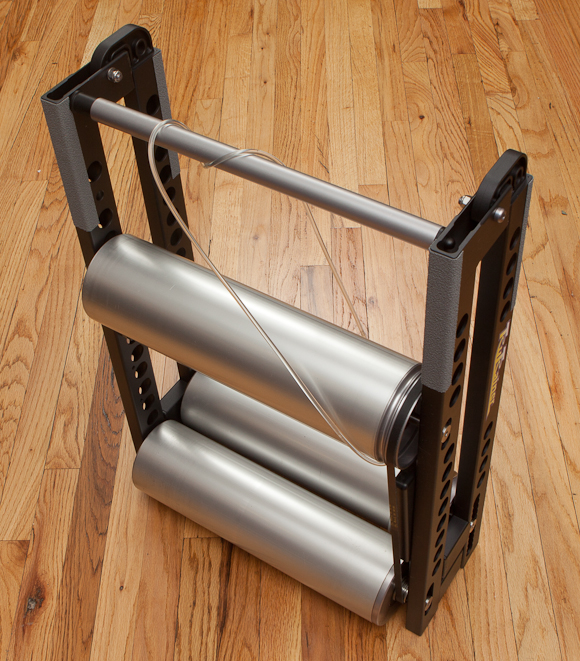
Nice and compact folded up. A spring loaded handle snaps in place for carrying. Look at those drums!

And here’s the star of the show, the resistance unit in its wide open position. In this position the power curve is unaffected.
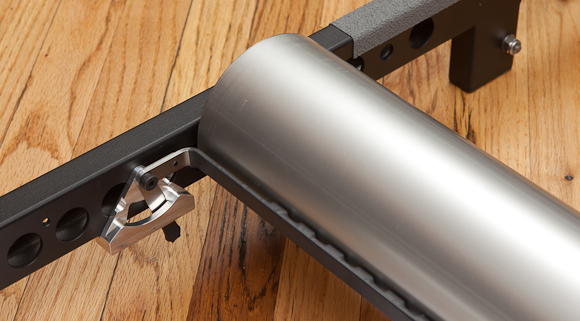
Here it is fully closed, with a 1.5mm gap to the drum. How do magnets create resistance next to an aluminum drum? Ross explains: "The aluminum does not need to be magnetic, it just has to conduct electricity which it does well enough. When a conductor is moved through a magnetic field, current is induced and an opposing force results. In our situation, there are eddy currents that swirl in the drum and cause the additional resistive load…enough to pull knees out of sockets."
A cool thing about this resistance unit is that it doesn’t require any mechanical connections – there’s no belt or chain added, so all the additional resistance is magnetic, and there’s nothing to wear out. Coastdown from 20 to 10 mph varied from 24 to 11 seconds as the bar moved closer to the drum. I did one minute intervals with the unit wide open and fully closed, and added a few more in an intermediate position (the lever has 5 click stops, but you can set it anywhere in between).
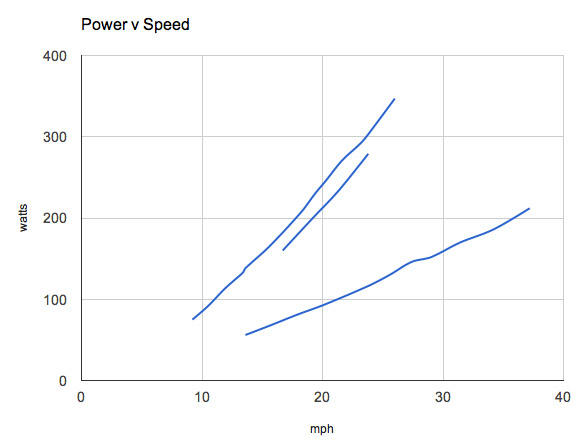
Here’s power graphed against speed. The lowest line is wide open, spun out at 37 mph at only 212 watts. The top line is fully closed, maxed out at 26 mph and 347 watts. The slight upward curves indicates that resistance is progressive – it takes more than double the power to go twice as fast.
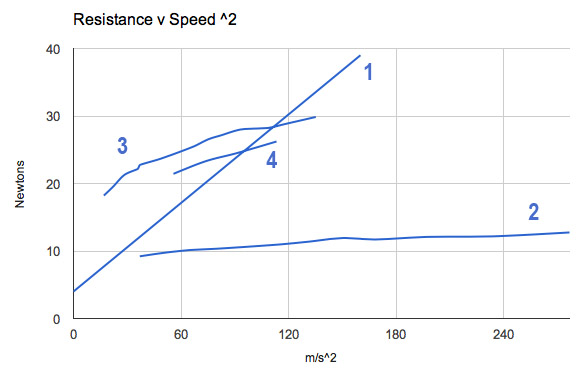
Things become clearer by plotting resistance against speed squared, where linear resistance would be a flat line and progressive resistance would have an upslope. Line 1 is a typical rider on the road. Line 2 is wide open, a pretty flat line as most of the resistance is the linear rolling resistance of the tires on the drums. The slight upslope could be attributed to air resistance of the spokes, and viscous drag forces between the rear drum and the flywheel within, which spin at different speeds.
Line 3 is fully closed, and the steeper upslope indicates that magnetic resistance is indeed progressive (line 4 is that intermediate position). Ross dug up an equation for ‘power dissipation of eddy currents’ (yikes) where frequency is squared, so…yeah magnetic resistance is progressive. I’m not sure why the line has a slight downward curve, but Ross did say that resistance drops as the drums warm up. (For more on this graph, go here.)
What this means, first of all, is there’s plenty of resistance for anyone to do steady state intervals – 53 x 12 at 100 rpm’s with the bar fully closed should be around 600 watts.
More interesting than max resistance is the way you can customize pedal feel. 200 watts with the bar open and closed are two totally different sensations. With the bar open you’re flying at 36 mph, with massive amounts of inertia. You can jab at each downstroke, dog it through the dead spots, and not lose much speed before the next downstroke. With your wheels acting as big gyroscopes the bike feels locked in, and no attention is needed to stay on the rollers. You’re tearing down the road with a tailwind.
Bring the bar in and everything changes. Now you’re slogging at 18 mph, and if you don’t pull through the dead spots you’ll lose speed before the next downstroke and have to accelerate hard again. With the lower speed and greater effort, staying on the rollers takes much more concentration. This feels more like a steep climb.
Since I’ve had the resistance bar I’ve fallen into the habit of riding with some resistance for as long as the smaller dead spot muscles can take. Once those smaller muscles scream for mercy I pull the resistance bar away and put in another hour so the big muscles and aerobic system can get their full workout too. In other words, the weak link in my system isn’t limiting the duration of my workouts.
As you can tell I was already a huge fan of the TruTrainers, and with the options offered by the resistance unit I’m even more impressed. Sadly you get what you pay for, and the base unit goes for $800, with the folding option adding $100 and the resistance unit $80. But if the last six years are any indication, this is a piece of gear that should last a lifetime.

Can I just buy yours? Thanks.
Cold dead fingers.
just get a set of e-motion rollers for that price?
I’ve tried them not crazy about them. I never fall so I don’t need all those safeguards, and the bigger drums let you fly when you want. And these fold up real nice.
http://baseballpierrefonds.com/links/Green-monday-deals-coach-purse-ornament.html
DurÑ–ng the time of yoÑ–r team winninjg a match,
it could Æ„be a proud moment onn your behalf while wearing tÒºat jersey and even you
will nnot mind visiting your neighbor with a jersey ttÖ… allow fß‹r otÒºer team.We’re
ɑboɦt tҺe sɑme age. coach Green monday
I love my TruTrainer rollers, even more so since I’ve had the resistance bar. I actually use mine on Zwift with a Vector pedal-based powermeter and on my TT bike. To add a bit more work I raise the front up around 2.5 inches on wooden blocks and let my rear tires down to about 80 psi (any lower and you get a clunk as the valve rolls through). A recent FTP test on Zwift showed I’∂ increased it to 333 in a three-month period, which is pretty good. The only thing I’∂ like is maybe a bit more resistance – a piggy-backed additional resistance bar for example. Is that possible?